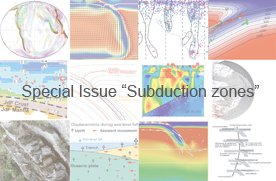The fate of fluids released from subducting slab in northern Cascadia
Abstract. Large amounts of water carried down in subduction zones are driven upward into the overlying forearc upper mantle and crust as increasing temperatures and pressure dehydrate the subducting crust. Through seismic tomography velocities we show (a) the overlying forearc mantle in northern Cascadia is hydrated to serpentinite, and (b) there is low Poisson's ratio at the base of the forearc lower crust that may represent silica deposited from the rising fluids. From the velocities observed in the forearc mantle, the volume of serpentinite estimated is ∼30 %. This mechanically weak hydrated forearc region has important consequences in limits to great earthquakes and to collision tectonics. An approximately 10 km thick lower crustal layer of low Poisson's ratio (σ = 0.22) in the forearc is estimated to represent a maximum addition of ∼14 % by volume of quartz (σ = 0.09). If this quartz is removed from rising silica-saturated fluids over long times, it represents a significant addition of silica to the continental crust and an important contributor to its average composition.






